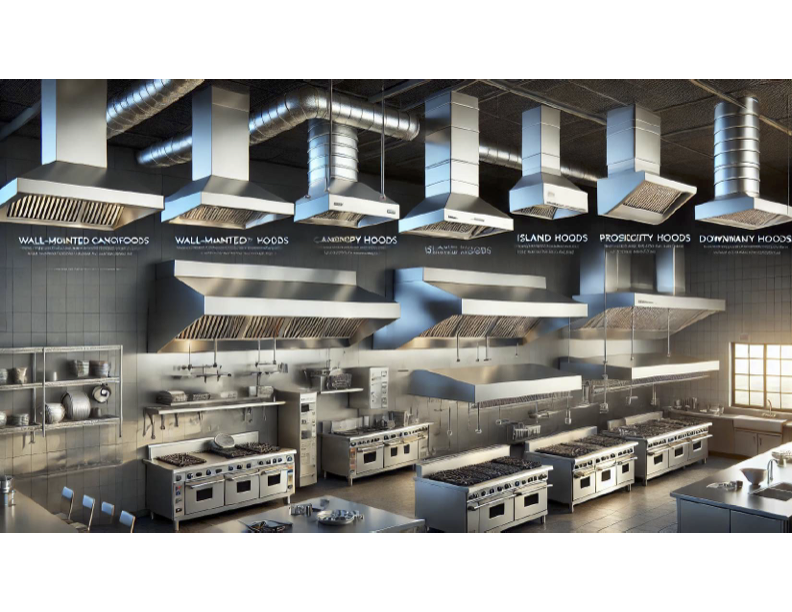In any commercial kitchen, proper ventilation is critical for maintaining air quality, ensuring safety, and meeting health regulations. Kitchen hood ventilation systems help remove heat, smoke, grease, and airborne contaminants, creating a safe and comfortable environment for staff while preventing fire hazards.
Here’s a breakdown of the different types of commercial kitchen hoods and ventilation systems:
1. Type I Hoods (Grease Hoods)
Type I hoods are designed to capture grease, smoke, and other airborne particles generated by cooking that involves grease-producing appliances, such as fryers, grills, and ranges. These hoods are required to have grease filters and are typically equipped with fire suppression systems to reduce fire risks.
-
Best for: Fryers, grills, broilers, ovens, and ranges
-
Required components: Grease filters, exhaust system, and fire suppression system
-
Installation considerations: Must be vented to the exterior of the building
2. Type II Hoods (Condensate Hoods)
Type II hoods, also called heat and steam hoods, are designed to capture steam, heat, and moisture rather than grease and smoke. These hoods are typically used with non-grease-producing appliances, such as dishwashers and steamers, to maintain a comfortable and dry work environment.
-
Best for: Dishwashers, steamers, and pasta cookers
-
Required components: Ductwork and exhaust fans (no grease filters needed)
-
Installation considerations: May be ducted or ductless depending on building requirements
3. Wall-Mounted Canopy Hoods
Wall-mounted canopy hoods are installed against a wall above cooking equipment, extending outward to capture heat, smoke, and grease-laden air. These are among the most common hood types in commercial kitchens.
-
Best for: Any grease-producing appliances against walls
-
Advantages: Effective at capturing and containing exhaust emissions
-
Installation considerations: Requires proper ductwork and external ventilation
4. Island Canopy Hoods
Island canopy hoods are suspended from the ceiling above cooking islands, allowing for overhead ventilation in kitchens where appliances are centrally located. These hoods require more powerful exhaust systems since they are open on all sides.
-
Best for: Centralized cooking stations, high-volume kitchens
-
Advantages: Provides open-space ventilation without wall restrictions
-
Installation considerations: Higher airflow requirements compared to wall-mounted hoods
5. Low-Proximity (Backshelf) Hoods
Low-proximity hoods, also called backshelf or proximity hoods, sit closer to the cooking surface and are often installed over smaller equipment like griddles and countertop fryers. These hoods are compact and efficient, requiring less airflow compared to larger canopy hoods.
-
Best for: Small cooking appliances, food trucks, and compact kitchens
-
Advantages: Space-saving, energy-efficient, and reduces air movement in the kitchen
-
Installation considerations: Must be properly sized to ensure effective capture of grease and heat
6. Ventless Hood Systems
Ventless hoods use built-in filtration systems to clean the air instead of exhausting it outside. These hoods typically incorporate multiple filters, including grease, charcoal, and HEPA filters, to remove contaminants before recirculating the air back into the kitchen.
-
Best for: Locations where ductwork installation is impractical (malls, food courts, mobile kitchens)
-
Advantages: No external venting required, flexible installation
-
Installation considerations: Requires frequent filter maintenance and replacement
Key Considerations When Choosing a Ventilation System
-
Local Codes & Regulations: Always ensure compliance with local fire and health codes.
-
Airflow Requirements: Proper ventilation calculations are necessary to determine exhaust volume needs.
-
Energy Efficiency: Choosing the right size hood and optimizing airflow can reduce energy costs.
-
Maintenance Needs: Regular cleaning of grease filters, ducts, and fans is essential to prevent buildup and fire hazards.
Final Thoughts
Selecting the right kitchen hood ventilation system is essential for both safety and efficiency. Whether you need a high-powered grease hood for heavy-duty frying or a ventless system for a small café, understanding the different options helps ensure a properly ventilated kitchen. Investing in the right system not only keeps your workspace safe but also improves air quality and operational efficiency.

